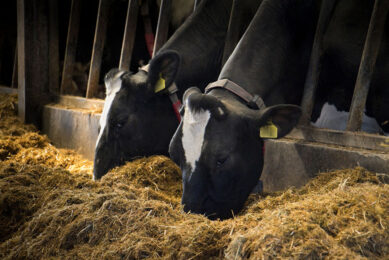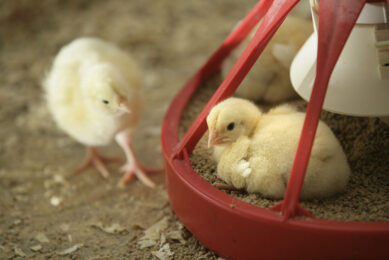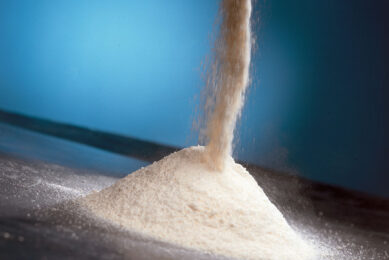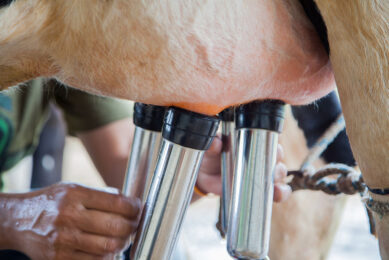Feed attractants and protein quality mean less waste
Feeding high protein diets to fish and shrimp may mean faster growth, but can be expensive and often wasteful. Less expensive protein sources can be a false economy as they often have low palatability and are less digestible, often leading to environmental as well as economic problems. Good evaluation of protein quality and the use of feeding attractants may help to reduce the problem.
Measures, to ensure that all feed offered to animals in commercial operation is consumed and, to reduce formulated feed waste pollution have been considered as some of the most relevant for lowering production costs in aquaculture. Considering the importance of chemical stimulants in the development of the crustacean life cycle, it is logical to assume that by adding attractants to the feed, the animal would rapidly find potential feed and ingest it. Additionally, measures involving the incorporation of protein from vegetable sources that, like soybean and peanut, when included at a high percentage of the feed formulation, lead to reduced levels of feed intake.
Considerable work has been reported on feed stimulants for fish and on diverse compounds thought to be attractants or feeding stimulants.
Modern diets used for feeding shrimp generally contain high levels of animal protein and fishmeal (Gatlin, 1997). It was suggested that a way to reduce the costs of diets for carnivorous animals is to use plant feedstuffs as a replacement for the more expensive animal protein (Tacon, 1994). A major obstacle to using high levels of plant feedstuffs, besides nutrient composition and availability, is poor acceptance of the diets. A decrease in feed intake was reported with inclusion of soybean meal in diets for rainbow trout (Cho et al., 1974), red drum (Reigh and Ellis, 1992) and channel catfish (Miohsen and Lovell, 1990). In addition, Davis et al. (1995) reported that soybean protein did not have acceptable palatability properties for red drum. McGoogan and Gatlin (1997) reported that glycine supplementation enhanced growth and feed efficiency of red drum fed soybean meal based diets. Gomes et al. (1997) showed that both soybean protein concentrate based diets as well as corn gluten meal based diets reduced feed intake of European sea bass. Furthermore, it was demonstrated in the same study that the addition of an amino acid attractant mixture improved feed intake, growth and feed efficiency of fish fed the same soybean protein concentrate based diets.
The purpose of this study was to assess the effects of several attractants on the growth performance of shrimp.
First attract your shrimp
In the first experiment conducted, an attractant test was carried out using the Y-model apparatus to determine the effects of 5’-inosine monophosphate, betaine (Betafin), fish hydrolysate (Primex L030, Norway), TMA-O (Trimethylaminoxid), or DMPT (Dimethyl-propiothetin) added to the basal diet designed to be non-attractive and characterised by high content of soybean meal (Table 1). The dosages of the attractants added are shown in Table 2.
The test was conducted in the apparatus shown in Figure 1. Fifteen shrimp (Panaeus chinensis) were put into the main container for 20 minutes to adapt. The experimental diet and control diet were put into two secondary containers (experimental area and control area, respectively). After 20 minutes, the fender was removed and the number of shrimp entering the experimental or control area respectively at five minute intervals were noted. The experiment was replicated four times for each test diet.
A second, growth experiment was carried out over a two month period in fibreglass tanks with 30 shrimp per tank. In this experiment, each treatment (in duplicate) was fed twice daily. Feed intake was recorded at each feeding (G fed per tank). Shrimp were weighed at the beginning and end of each treatment. Feed intake, growth and feed conversion ratios (FCR) were calculated as follows:
| Attractant rate | = | {(E-A)/A}x 100% |
| Where | E= | Total number of shrimp in experimental area |
| A= | Total number of shrimp in control area | |
| FCR= | Feed given/Weight gain |
Feed intake and growth response
The results obtained in the attractant experiment are shown in Table 3. The attractant rate of DMPT on shrimp was the strongest compared. The attractant rates of fish hydrolysate and betaine rated second, with the values for 5’-inosine monophosphate and TMA-O the lowest.
Table 4 summarises the effects of five attractants on survival, growth and FCR. Significant (P<0.05) increases in rate of weight gain and improved FCR were achieved in the diet supplemented with DMPT. Compared with the controls, there were significant (P<0.05) increases in rate of weight gain of shrimp fed the basic diet supplemented with all experimental attractants.
Of the five experimental attractants used, only betaine, fish hydrolysate and DMPT resulted in a significant response when tested individually with shrimp, but there was a significant (P<0.05) promotion of growth of the shrimp fed a basic diet with a mix of the five experimental diets. Most studies conducted to date with attractants for shrimp have focused on the short-term attractant efficiency, neglecting the importance of prolonged studies in the form of growth trials. Long-term studies can better describe the effects of attractants in a grow out operation. It has already been suggested that attractants lose their potency if fed in diets for prolonged periods. Results from our study indicate that supplementation of a plant basal diet with an attractant improved growth performance.
Fishmeal quality an important factor
Inherent to the practice of intensive aquaculture is the generation of waste having immediate and very broad effects on the aquatic environment. There is a growing consensus about the need to reduce waste production in aquaculture to minimise negative effects on the environment. As with other areas of agriculture, nitrogen (N) and phosphorus (P) are major concerns for many aquaculture operations.
In the past, formulation of diets for intensive aquaculture was aimed primarily at meeting requirements for maximum growth, while more recently, they are designed to meet other desired production goals. One such goal is to increase the sustainability of various aquacultural enterprises by reducing their environmental impact on the surrounding ecosystems. Aquaculture waste is largely dietary in origin, with estimates of 52-95% of feed nitrogen ending up as waste (Wu, 1995). Protein digestibility which results in less waste production is therefore an attractive approach to this problem. One approach is to formulate diets to minimise ammonia production.
While high dietary protein digestibility is known to result in rapid growth rates for many species of fish, low protein digestibility results in high levels of ammonia production (Campbell, 1991). Its reduction is understandably desirable as it represents a loss of costly amino acid nitrogen from protein synthesis and is a source of pollution detrimental to water quality even at moderately low levels. One practice that has been employed in aquaculture is to limit ammonia production by increasing the rate of protein digestibility, to reduce ammonia production, but sustain rapid growth.
Intensive farming of carnivorous fish is currently dependent upon the use of fishmeal and other fishery products as major sources of dietary protein (Tacon, 1994). Proper consumption of feed ingredients with high digestibility is crucial for the optimal growth and feed efficiency of fish and so is of potential economic value for the aquaculture industry. Nutrient digestibility will affect fish farm effluent and pollution of the environment. In addition, any effect of fishmeal quality is important for the interpretation of the results obtained in studies of fishmeal replacement, as varying fishmeal quality will probably give varying replacement effects. The quality of feed is very important for growth, FCR, waste excretion and fish health.
Fishmeal quality
Three experimental diets were prepared using “poor quality” fishmeal, a “good quality” fishmeal and an imported Peru fishmeal (Yellow Sea Fisheries Research Institute). All diets were pelleted by cold compression. Chromic oxide was added at 1% in all experimental feeds to determine protein digestibility. Diets were based largely on fishmeal.
The red seabream were randomly kept in groups of 30 fish in 50-litre fibreglass tanks supplied with a continuous flow (20l/h) of filtered seawater. The initial body weight of the fish was 19.5g on average. The experiment was run in duplicate for a two month period at a temperature of 17-26°C. Fish were weighed once each month. The diets were fed slowly to appetite and to minimise losses due to uneaten feed. Feed consumption was recorded. Dissolved O2 levels in the tanks ranged from 7.4 to 8.1 mg/l. Mortalities were removed. At the end of the experiment, all fish were weighed.
The shrimp experiment was conducted in similar tanks and manner to that with red seabream (in duplicate). Average body weight at the beginning of the two-month long experiment was 0.85g and shrimp were weighed each month. Feed consumption was measured.
Experimental diets were fed twice per day in both experiments, at 0900 and 1500 hours. Faecal matter was collected at 12 hour intervals. The protein content of diets and faeces were measured by Kjeldahl analysis. Chromium was determined spectrophotmetrically after nitric acid and perchloric acid digestion. Apparent protein digestibility and DM digestibility were calculated.
Quality better all-round
Growth, survival, FCR, protein and DM digestibility are presented for shrimp in Table 5. Most of the shrimp losses were due to the shrimps jumping out of their tanks. Survival rates of shrimps fed good quality and Peru fishmeal showed no significant differences (Pª 0.5) compared with poor quality fishmeal, but the survival rate of shrimp fed poor quality fishmeal was lower compared to those on the other diets. Poor quality fishmeal also caused a significant (P<0.01) reduction in weight gain compared to good quality fishmeal. Moreover, the good quality fishmeal had a protein digestibility that was 63.7% greater than the poor quality fishmeal diet. Protein digestibility of imported fishmeal diets was between 60.0 and 60.8% better than the poor quality fishmeal. In addition, significant differences were found in the FCR of the three diets (P<0.01).
In the red seabream experiment, all diets were well accepted by the fish, so there was no significant difference in the feed intake. Growth, survival, FCR and digestibility of protein and DM are shown in Table 6. Survival rates of red seabream fed good quality and imported fishmeal was higher than the low-quality fishmeal diet. Poor quality fishmeal caused a significant (P<0.01) decrease in the rate of weight gain. Moreover, protein digestibility values were greatly influenced by the fishmeal used (P<0.05). In addition, there were significant differences in the FCR.
In the present study, both shrimp and red seabream fed diets based on low-quality fishmeal showed reduced growth compared with the high-quality fishmeal. A similar reduction in feed utilisation was observed.
The growth reduction from poor quality fishmeal confirmed previous results with salmon smoults (Pike, 1991; Anderson et al., 1997), halibut (Asknes and Mundheim, 1997) and shrimp (Rique Marie et al., 1994 a, b). Contrary to these findings, Watanabe et al. (1987) reported increased growth in rainbow trout fingerlings fed fishmeal made from moderately stale mackerel (66.9mg histamine/kg) compared to that of fishmeal made from fresh mackerel (3.9mg histamine/kg). It appears that the mackerel used by Watanabe et al. (1987) was less stale than the poor quality fishmeal used in this and previously reported studies with the same outcome, which may explain the results.
Due to the design of the present study, it is not possible to conclude whether the growth reduction was seen in the shrimp and red seabream fed poor-quality diets, was due to diminished appetite, reduced feed consumption, reduced nutrient content or availability or toxic factors. The possibility cannot be ruled out that the diet based on poor quality fishmeal was less palatable than the other diets. Reduced palatability can occur through the loss of feed attractants or by lipid oxidation.
The good quality fishmeal used in this study had higher protein digestibility than that of poor quality fishmeal, which implies that the availability of the amino acids were very different in the three meals. Although the total amino acid content was not measured in this study previous work (Aksnes, 1989) has shown that reductions in amino acid content can vary from nil (valine) to 41% (histidine).
References available on request











